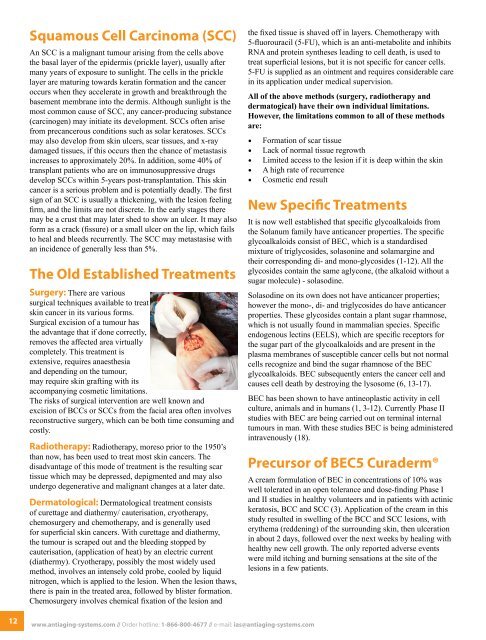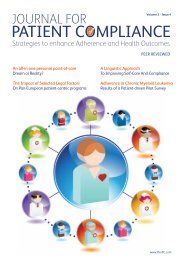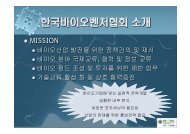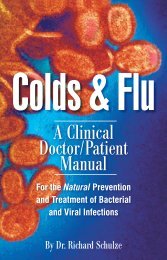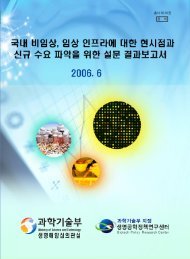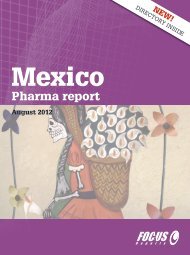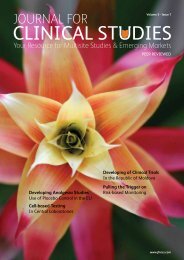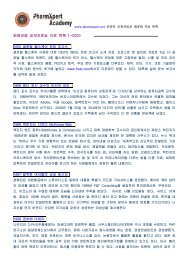Nanogen - PharmXpert Academy
Nanogen - PharmXpert Academy
Nanogen - PharmXpert Academy
Create successful ePaper yourself
Turn your PDF publications into a flip-book with our unique Google optimized e-Paper software.
Squamous Cell Carcinoma (SCC)<br />
An SCC is a malignant tumour arising from the cells above<br />
the basal layer of the epidermis (prickle layer), usually after<br />
many years of exposure to sunlight. The cells in the prickle<br />
layer are maturing towards keratin formation and the cancer<br />
occurs when they accelerate in growth and breakthrough the<br />
basement membrane into the dermis. Although sunlight is the<br />
most common cause of SCC, any cancer-producing substance<br />
(carcinogen) may initiate its development. SCCs often arise<br />
from precancerous conditions such as solar keratoses. SCCs<br />
may also develop from skin ulcers, scar tissues, and x-ray<br />
damaged tissues, if this occurs then the chance of metastasis<br />
increases to approximately 20%. In addition, some 40% of<br />
transplant patients who are on immunosuppressive drugs<br />
develop SCCs within 5-years post-transplantation. This skin<br />
cancer is a serious problem and is potentially deadly. The first<br />
sign of an SCC is usually a thickening, with the lesion feeling<br />
firm, and the limits are not discrete. In the early stages there<br />
may be a crust that may later shed to show an ulcer. It may also<br />
form as a crack (fissure) or a small ulcer on the lip, which fails<br />
to heal and bleeds recurrently. The SCC may metastasise with<br />
an incidence of generally less than 5%.<br />
The Old Established Treatments<br />
Surgery: There are various<br />
surgical techniques available to treat<br />
skin cancer in its various forms.<br />
Surgical excision of a tumour has<br />
the advantage that if done correctly,<br />
removes the affected area virtually<br />
completely. This treatment is<br />
extensive, requires anaesthesia<br />
and depending on the tumour,<br />
may require skin grafting with its<br />
accompanying cosmetic limitations.<br />
The risks of surgical intervention are well known and<br />
excision of BCCs or SCCs from the facial area often involves<br />
reconstructive surgery, which can be both time consuming and<br />
costly.<br />
Radiotherapy: Radiotherapy, moreso prior to the 1950’s<br />
than now, has been used to treat most skin cancers. The<br />
disadvantage of this mode of treatment is the resulting scar<br />
tissue which may be depressed, depigmented and may also<br />
undergo degenerative and malignant changes at a later date.<br />
Dermatological: Dermatological treatment consists<br />
of curettage and diathermy/ cauterisation, cryotherapy,<br />
chemosurgery and chemotherapy, and is generally used<br />
for superficial skin cancers. With curettage and diathermy,<br />
the tumour is scraped out and the bleeding stopped by<br />
cauterisation, (application of heat) by an electric current<br />
(diathermy). Cryotherapy, possibly the most widely used<br />
method, involves an intensely cold probe, cooled by liquid<br />
nitrogen, which is applied to the lesion. When the lesion thaws,<br />
there is pain in the treated area, followed by blister formation.<br />
Chemosurgery involves chemical fixation of the lesion and<br />
the fixed tissue is shaved off in layers. Chemotherapy with<br />
5-fluorouracil (5-FU), which is an anti-metabolite and inhibits<br />
RNA and protein syntheses leading to cell death, is used to<br />
treat superficial lesions, but it is not specific for cancer cells.<br />
5-FU is supplied as an ointment and requires considerable care<br />
in its application under medical supervision.<br />
All of the above methods (surgery, radiotherapy and<br />
dermatogical) have their own individual limitations.<br />
However, the limitations common to all of these methods<br />
are:<br />
• Formation of scar tissue<br />
• Lack of normal tissue regrowth<br />
• Limited access to the lesion if it is deep within the skin<br />
• A high rate of recurrence<br />
• Cosmetic end result<br />
New Specific Treatments<br />
It is now well established that specific glycoalkaloids from<br />
the Solanum family have anticancer properties. The specific<br />
glycoalkaloids consist of BEC, which is a standardised<br />
mixture of triglycosides, solasonine and solamargine and<br />
their corresponding di- and mono-glycosides (1-12). All the<br />
glycosides contain the same aglycone, (the alkaloid without a<br />
sugar molecule) - solasodine.<br />
Solasodine on its own does not have anticancer properties;<br />
however the mono-, di- and triglycosides do have anticancer<br />
properties. These glycosides contain a plant sugar rhamnose,<br />
which is not usually found in mammalian species. Specific<br />
endogenous lectins (EELS), which are specific receptors for<br />
the sugar part of the glycoalkaloids and are present in the<br />
plasma membranes of susceptible cancer cells but not normal<br />
cells recognize and bind the sugar rhamnose of the BEC<br />
glycoalkaloids. BEC subsequently enters the cancer cell and<br />
causes cell death by destroying the lysosome (6, 13-17).<br />
BEC has been shown to have antineoplastic activity in cell<br />
culture, animals and in humans (1, 3-12). Currently Phase II<br />
studies with BEC are being carried out on terminal internal<br />
tumours in man. With these studies BEC is being administered<br />
intravenously (18).<br />
Precursor of BEC5 Curaderm®<br />
A cream formulation of BEC in concentrations of 10% was<br />
well tolerated in an open tolerance and dose-finding Phase I<br />
and II studies in healthy volunteers and in patients with actinic<br />
keratosis, BCC and SCC (3). Application of the cream in this<br />
study resulted in swelling of the BCC and SCC lesions, with<br />
erythema (reddening) of the surrounding skin, then ulceration<br />
in about 2 days, followed over the next weeks by healing with<br />
healthy new cell growth. The only reported adverse events<br />
were mild itching and burning sensations at the site of the<br />
lesions in a few patients.<br />
12<br />
www.antiaging-systems.com // Order hotline: 1-866-800-4677 // e-mail: ias@antiaging-systems.com


